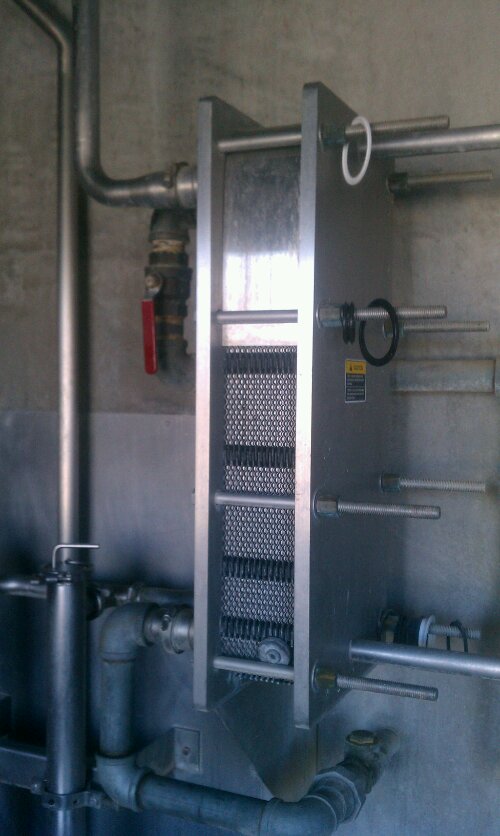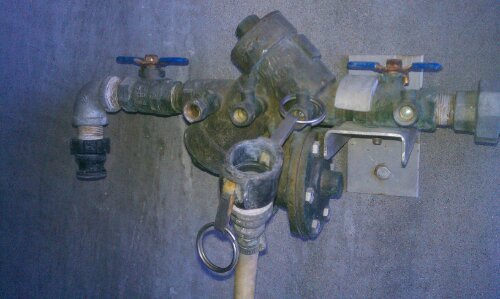Ray-Lin Dairy
Dairy Management
Is my milk safe?
Cleanliness and safety is something that we think about before we even think about milking the cows. Cleanliness starts with the cow beds andalso by keeping our cows healthy . We wash our milk pipelines three times a day once between every milking shift, the milk tank is washed once a day after it has been emptied and the milk pumped out and onto the tanker truck. Food safety is something paid close attention to on a dairy farm here are few pictures showing what we do to produce healthy refreshing milk!

This tank cools the milk and stores it at a chilly 39 degrees. This is a brand new 5000 gallon milk tank we installed a few months ago.

Inside these stainless steel tubes the milk is filtered before ending up in the milk tank. Fresh new filters are installed before each milking shift.

This is a plate cooler that uses water to help cool the milk by nearly 20 degrees before the milk enters the milk tank.

This chart tracks the temperature of the milk and is changed every 48 hours. If you notice the two spikes in temperature they are when the tank is washed daily after the milk is pumped into the milk truck to be taken to the milk plant.

This sink is where the cleaning agents are m ixed with water to wash the pipelines the milk flows through. It is like a big dishwasher for pipes and is used after each milking shift.

the cows teats are dipped with an 1% iodine and lanolin solution to keep them soft and clean.

Although hard to see because it is a clear gold color this is a peroxide based teat sanitizer we use before the cow is milked. It also has lanolin in it to keep the teats soft..

The cleaning agents are automatically added to the wash sink for employee safety.

We even take safety as far as protecting our water supply from being contaminated with cleaning agents or milk.

The milking machines are washed in between every milking shift
Cows play in sprinklers? Wordless Wednesday
This started out as a Wordless Wednesday however I decided to add some background information.
Today I’m doing maintenance work on one of the major pieces in our cow comfort system the soakers that help keep the cows cool during the summer.
Here is a picture of the cows enjoying the cool shower just like kids playing in the sprinkler do during the summer.

Cows being cooled by the soaker system.
The soakers come turn on to soak the cows and then are off for a period of time to allow the water to evaporate and creating evaporative cooling. This type of cooling is the same cooling feeling you get right after getting out of a swimming pool on a hot day. We locate the soakers over the cows food so they are more comfortable while eating and their food intake stay’s up during hot days when they need the energy.

This little box is a great help to keep cows comfortable
This controller uses the temperature at the cow level to adjust the on and off times so the optimum cooling of the cows is maintained.
Posted from WordPress for Android
Dairy cares? Environment
Here is a quick update about dairies in California’s Central valley and their progress with environmental regulations
Dairy Cares Report
February 2011
www.dairycares.com

Working together, we can continue to make our communities and state a better place to live and raise our families.
Myths vs. facts: Much progress made in dairy water quality protection efforts
It is an indisputable fact that in the past four years, California dairy families have invested more than $150 million in landmark water quality protection efforts. And here are a few other such facts:
- California’s Central Valley has the most comprehensive dairy groundwater quality protection regulations in the nation;
- Individual dairy families have spent thousands of hours since 2007 taking specific measures, every day on every dairy, to enhance water quality protection and stewardship of the soil, land and other natural resources; and
- Dairies have done all this while enduring a historic struggle to survive, through a global economic downturn that drove more than 200 of the state’s dairies out of business.
California dairy families deserve recognition and credit for their efforts to protect groundwater. Dairy farmers here are leading efforts in our state and across the nation to use best practices that will help ensure sustainable food production in the Central Valley for centuries to come.
Strangely, dairy families were recently rewarded for their efforts with a different variety of recognition, one that leads cynics to observe: “No good deed goes unpunished.” Food & Water Watch (FWW), a national organization whose stated goal is to “ensure the food, water and fish we consume is safe, accessible and sustainable,” last week published a report condemning the efforts of California water quality regulators and dairy operators. Acknowledging that “dairy waste is by no means to the sole source of groundwater contamination,” and that dairy regulation has only recently been launched, FWW nevertheless pronounced efforts to date a failure.
FWW’s central premise – that poor quality water in many Central Valley wells points to the failure of dairy regulatory efforts – is simply dead wrong. Poor groundwater quality in our valley wells is a legacy problem that has been developing in the Central Valley for many decades, indeed since irrigated agriculture and use of fertilizers began in the valley more than 150 years ago. In fact, many of the most serious contributors to poor well water quality in valley communities, such as arsenic and boron, occur naturally in the soil and are not produced by agriculture or dairies. There are also other man-made sources of water pollution, including rural septic systems, urban and industrial sources, and the list goes on.
Dairy families are doing their part. In 2007, acknowledging that all must share the effort to protect and improve our water quality, dairy families stepped forward to work with regulators toward meeting the challenge of continued, long-term sustainable farming in our valley. They have made tremendous progress in just four years, including:
- Conducting regular sampling of all wells on every dairy to monitor water quality;
- Controlling all applications of manure and fertilizers to crops through a “nutrient management plan,” prepared by a certified professional to balance the fertilizer needs of the plants and protect groundwater from excess fertilizer;
- Making sure an engineer has inspected and signed off on any manure storage structures to ensure they are structurally sound and protected against floods; and
- Working with regulatory enforcement staff to ensure that these improvements are continuous, properly documented and enforceable, through submittal of reports and lab results, other records, and routine inspections.
But apparently, significant progress isn’t enough. FWW seems to be suggesting that only four years into implementing a complex, tough and expensive regulation, all Central Valley groundwater quality challenges should already be solved. Never mind that the current state of valley groundwater developed slowly over more than a century (in some cases, over millennia) and that we have barely allowed time for the newly implemented regulations to begin to reverse the trend. And never mind that regulating dairies alone won’t solve the problem. Like other environmental impacts, groundwater impacts come from myriad natural and man-made sources – and for many of these other causes, little has yet been attempted to address the problem.
In a final twist that is either remarkably unfair or grossly uninformed, FWW points to larger “industrialized” dairies as the source of the problem. Using the time-tested argument that “big must always be bad,” and using the pejorative term “industrialized” to equate larger farms with heartless factories, FWW suggests the government must act to make dairies smaller. Without a shred of evidence to back their claims, they suggest larger dairies have a disproportionate environmental impact. This sort of misinformation is not just wrong, but dangerously misleading. It suggests that we magically achieve environmental sustainability through size alone. In fact, best practices such as those described above – proper fertilizer application, and sound engineering and management – are the real key for sustainable dairies large or small. We should recognize, not criticize, the significant investment of many larger dairies in state-of-the-art environmental management systems, often to meet California-specific requirements.
Regardless of size, another indisputable fact is that 99 percent of California dairies are owned and cared for by families in the business for generations, families who understand and share the core values of protecting land, water and air resources, because they depend on them to survive and prosper. FWW can try to paint these people as uncaring, but that’s wrong and unfair.
FWW claims their goal is food and water that is “safe, sustainable and accessible” for all. Dairy families deserve to be judged by their actions, not FWW’s skewed, misinformed words. While FWW criticizes, California dairy families are actually doing what it takes to protect groundwater while producing a safe, sustainable, nutritious and affordable food supply for millions of Americans.
Does a major news outlet have more half truths than Pinocchio?
As some people may know I was appointed last year to National Dairy Board by the Secretary of Agriculture Tom Vilsack. I was excited to help direct the programs dairy farmers fund from their own income, approximately 1.75 cents per gallon with 2/3 staying local & 1/3 going to the NDB. Afterall, my family farm has been contributing to the fund based on the milk products we have produced for close to two decades.
What I did not realize going in was the great dairy farmers I would meet along the way from all corners of the US, between the National, and State or Regional boards there are over 400 dedicated farmers giving their time to direct the programs all the dairy farmers fund.
I see first-hand how much mind-blowing research is done through the funds farmers like me put into the dairy board budget. There is research on the nutritional qualities of dairy products, packaging that allows milk to store better and be easier to take on the go and the amount of time spent on promotional programs like Fuel up to Play 60 a great partnership with the NFL to get kids active.
What I do not understand is why there is even a question about farmers promoting the products they grow and raise today their are numerous organizations that are self funded “Checkoffs” or marketing boards in the US. As stated in the popular Year of Plenty blog “… I’m not sure why it’s controversial that dairy farmers are paying for programs to promote the sale of their products. It’s like saying it’s scandalous that Starbucks wants consumers to drink more coffee.” Another great post from Year of Plenty is titled How My Little Blog Out-Reported the New York Times and adresses a lot of the misinformation and half truths.
With the inaccuracies reported by major news outlets, several dairy farmers across the US are voicing their sentiments in their own blog posts or in conversations with local media. Here are a few great posts from some fellow dairy farmers:
- The Dairy Mom Brenda Souza Hastings
- Orange Patch Dairy Shannon Seifert
- Dairy Goddess Barbara Martin
- The Wife of a Dairyman Nancy Grossi
Here is a great blog that is written by some of the great employees behind the the National dairy Council and Dairy Management Inc.:
